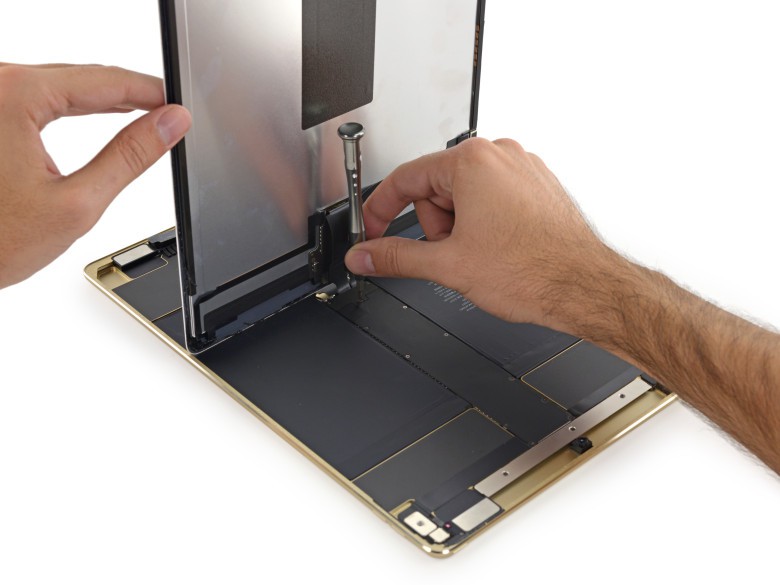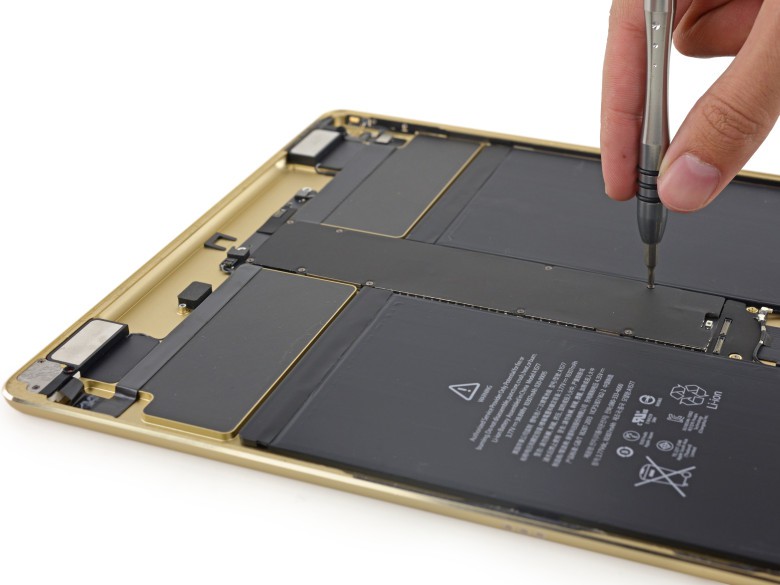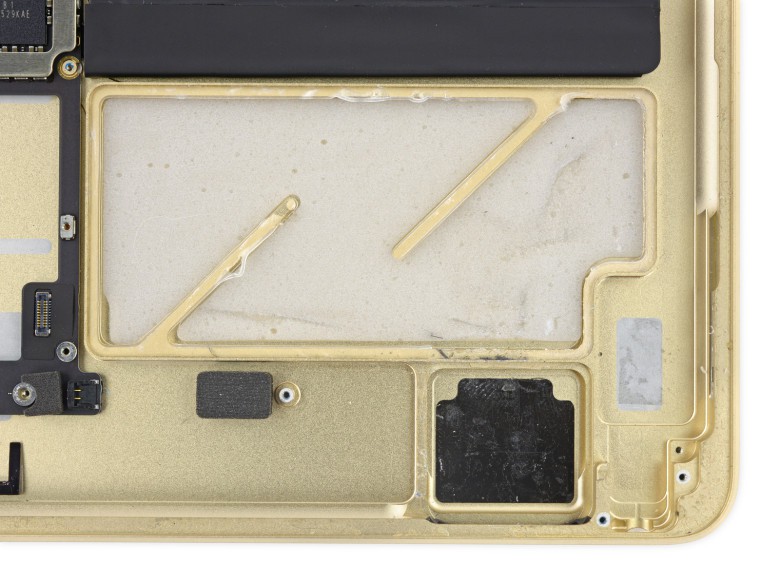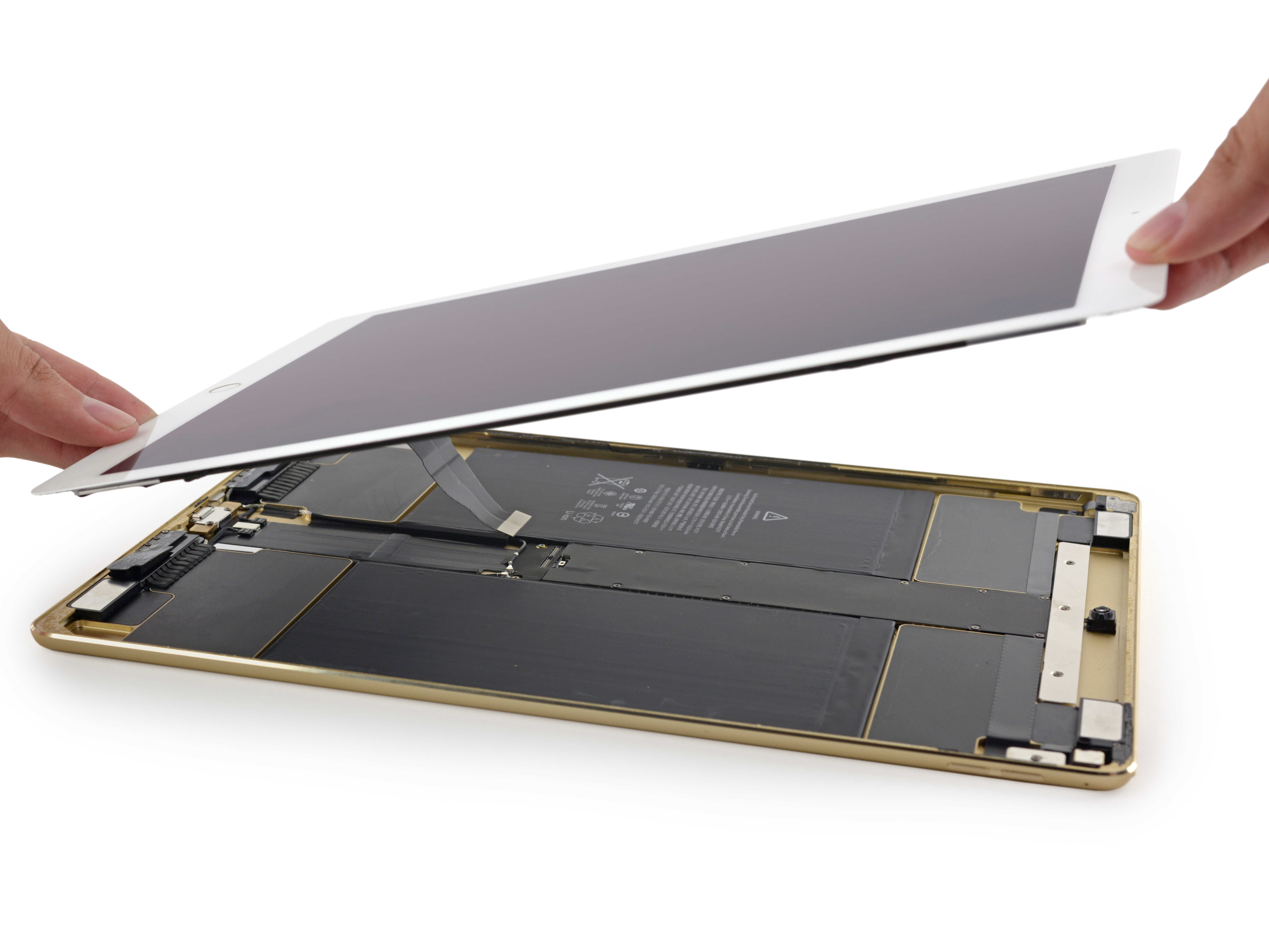A teardown of the just-released iPad Pro has revealed one of the secrets behind Apple’s redesigned sound system: chambers filled with sound-amplifying foam.
That’s the best guess from the folks at do-it-yourself repair site iFixit, who are strategically dismantling the new tablet as we speak.
As of this writing, iFixit’s iPad Pro teardown is still in progress, but the inside look at Apple’s latest and largest tablet has already revealed some surprising details.
For one, unlike the iPad Air 2 before it, the Pro’s display cables connect directly in the middle of the device instead of along the lower edge. That shouldn’t affect much, if anything, from a user’s perspective, but it presents a pretty big challenge when you’re trying to dismantle the device. Because these cables aren’t serving as a hinge of sorts, letting iFixit lay the display on the table while they disconnect it, they had to hold up the screen while removing the final screws holding it in place.

Photo: iFixit
The tearers-down compared this to the screen replacement process on an iPhone 6s, which requires the repairer to prop up the display while disconnecting it so as not to damage the connectors.
The iPad Pro teardown has also uncovered what iFixit calls “a first in iPad history”: In order to access the logic board, the team had to get past the electromagnetic interference shielding on top of it. This layer is like the tablet’s tinfoil hat, protecting its brain from harmful rays and outside tinkering.

Photo: iFixit
But how about that foam?
Apple has been talking up the iPad Pro’s new-fangled sound system, which contains four speakers that adjust their output depending on the orientation of the tablet. The speakers know whether you’re holding the iPad Pro horizontally or vertically (or upside-down, presumably), and it will always send higher-frequency sound output to whichever two speakers are on top. This is to ensure proper sound balance from the new arrangement.
Previous iPads have just carried their speakers at the bottom, which meant that unless you had it on a stand or were holding it in portrait mode without resting it on your lap at all, you were going to block some of your sound. I’ve just gotten really good at forming whichever hand was on that side into a resonance chamber to make the best of it.
The iPad Pro teardown, however, reveals that the new tablet has its own resonance chambers built right in under the hood (they have plenty of space for that sort of thing now). They’re right next to the drivers, obviously, and protected with a layer of carbon fiber. Under that fiber, though? Foam.

Photo: iFixit
iFixit guesses that the foam serves sound-amplification purposes, but I suspect that Apple just had a lot of foam lying around somewhere and realized that the absolute best way to get rid of it was to smuggle it out inside of the iPad Pro. That could actually be why they made the thing in the first place: It’s not just a next-generation tablet, a direct competitor to Microsoft’s Surface Pro, and the company’s attempt to create killer hardware for creators and enterprises.
It’s actually a foam mule.



9 responses to “Inside of iPad Pro contains way more foam than you’d expect”
“sound amplifying foam”???????? No such thing. Since they are putting foam inside a chamber or port, it’s probably to control the sound by providing some damping because it might be reflecting the audio in a manner where it doesn’t sound good. if you look at a traditional speaker box, they typically use some sort of internal foam or some form of sound absorption to control the internal reflections. But sound amplifying foam? NOPE. Foam is an absorption material typically absorbing mid range and higher frequencies within the audible audio spectrum.
Thank you for this comment. You are so correct. Either for dampening internal reflections or tuning of bass frequencies. Sometimes they will stuff a cabinet with foam or blanket filler to tune the cabinet correctly so it can producer lower frequencies.
No, it’s damping. Dampening is to make something wet or less intense. Common mistake. Don’t worry, even many people in the audio world make that mistake. :-)
The problem is that foam is not effective at low frequencies much under 125Hz. It’s the most effective at 500Hz and above, and becomes less effective between 500Hz and 125Hz, below 125Hz, it does absolutely nothing. you need completely different technology to deal with frequencies below 125Hz.
In order to deal with low frequencies, they have to make the cabinet larger, speakers larger, I doubt there is much really low end coming out of these speakers.. I mean, come on, if you put your hears right up to them, maybe, but let’s be real. They made the cabinet larger by how they designed it with those slots to channel the sound, but I don’t know what their frequency response curve is going to be at 1.5 to 2 feet away from the sound source (which is where your ears are).
Since the surface area of the back is so large, they have to have a lot of damping so the aluminum doesn’t resonate so much, for this I’m sure foam is just fine, instead of something much heavier/expensive as Dynamat..
The other thing is that we are dealing with very thin aluminum and it’s going to have a “ring” to it once the surface area gets large enough, so they are just cutting that ring, is my guess. Obviously we aren’t going to have measurement equipment with two IPad Pros (one with and without internal foam) to measure the difference, but it’s just to cut down weird ringing and vibrations.
This. It’s just there so you don’t hear a ‘thud’ if you bump the hollow areas.
Sometimes I think iFixIt should change their name to iDon’tKnow$hit. :-)
This is exactly what I was thinking when I read the article. I also believe that the foam may be helpful in reducing vibration from the sound that is produced.
You beat me to it.
“Inside of iPad Pro contains way more foam than you’d expect”
So does this article.